Reservoir Reliability as Affected by Climate Change and Strategies for Adaptation
Abstract
:1. Introduction
2. Materials and Methods
2.1. Reservoir Reliability and Adaptation Scheme for a Changing Climate
2.2. Reservoir and Watershed Characterization
2.3. Model Calibration and Validation
2.4. Reservoir Reliability
2.5. Hydrologic Projection Scenarios
2.5.1. RCM Projections and Ensembles
2.5.2. Bias Correction of P and T
2.5.3. Projections of Reservoir Inflows and Watershed Water Budget
2.5.4. Comparison of Historic and Future Climate and Hydrology
2.6. Reservoir Adaptation Measures
3. Results
3.1. Runoff Model Calibration and Validation
3.2. Bias Correction of Climate Data
3.3. Climate Projections and Climate Change
3.4. Hydrologic Projections and Impacts in Reservoir Hydrology
3.5. Reservoir Reliability in the Historic Period
3.6. Reservoir Reliability in Future Scenarios
3.7. Reservoir Reliability with Climate Change Adaptation
4. Discussion
4.1. Runoff Model Calibration and Climatic Bias Correction
4.2. Climate and Hydrology Projections
4.3. Reservoir Reliability in the Historic Period
4.4. Reservoir Reliability in Future Climate Scenarios
4.5. Reservoir Adaptation to Climate Change
5. Conclusions
Author Contributions
Funding
Data Availability Statement
Acknowledgments
Conflicts of Interest
References
- Jagger, H.I.; Smith, B.T. Sustainable Reservoir Operation: Can We Generate Hydropower and Preserve Ecosystem Values? River Res. Appl. 2008, 24, 340–352. [Google Scholar] [CrossRef]
- Koutsoyiannis, D. Hydrologic Persistence and The Hurst Phenomenon. Water Encycl. 2005, 10, 210–221. [Google Scholar] [CrossRef]
- Carty, J.G.; Cunnane, C. An Evaluation of Some Methods of Determining Storage Yield Relationships for Impounding Reservoirs. J. IWEM 1990, 4, 35–43. [Google Scholar] [CrossRef]
- Nagy, I.V.; Asante-Duah, K.; Zsuffa, I. Hydrological Dimensioning and Operation of Reservoirs. In Pratical Design Concepts and Principles; Springer: Cham, Switzerland, 2002; Volume 5, ISBN 9781119130536. [Google Scholar]
- Wallis, R.; O’Connell, P.E. Firm Reservoir Yield—How Reliable Are Historic Hydrological Records? Hydrol. Sci. J. 1973, 18, 347–365. [Google Scholar] [CrossRef]
- Vogel, R.M.; Tsai, Y.; Limbrunner, J.F. The Regional Persistence and Variability of Annual Streamflow in the United States. Water Resour. Res. 1998, 3, 3445–3459. [Google Scholar] [CrossRef] [Green Version]
- Cheng, W.M.; Huang, C.L.; Hsu, N.S.; Wei, C.C. Risk Analysis of Reservoir Operations Considering Short-Term Flood Control and Long-Term Water Supply: A Case Study for the Da-Han Creek Basin in Taiwan. Water 2017, 9, 424. [Google Scholar] [CrossRef] [Green Version]
- Papamichail, D.M.; Geourgiou, P.E. Seasonal Arima Inflow Model for Reservoir Sizing. J. Am. Water Resour. Assoc. 2001, 37, 877–885. [Google Scholar] [CrossRef]
- Chaves, H.M.L.; Lorena, D.R. Assessing Reservoir Reliability Using Classical and Long-Memory Statistics. J. Hydrol. Reg. Stud. 2019, 26, 100641. [Google Scholar] [CrossRef]
- Koutsoyiannis, D. Climate Change, the Hurst Phenomenon, and Hydrological Statistics. Hydrol. Sci. J. 2003, 48, 3–24. [Google Scholar] [CrossRef]
- Ahmadi, M.; Haddad, O.B.; Loáiciga, H.A. Adaptive Reservoir Operation Rules Under Climatic Change. Water Resour. Manag. 2015, 29, 1247–1266. [Google Scholar] [CrossRef]
- Nguyen, H.; Mehrotra, R.; Sharma, A. Assessment of Climate Change Impacts on Reservoir Storage Reliability, Resilience, and Vulnerability Using a Multivariate Frequency Bias Correction Approach. Water Resour. Res. 2020, 56, e2019WR026022. [Google Scholar] [CrossRef]
- Quan, V.D. Kittiwet Kuntiyawichai Identifying Adaptive Reservoir Operation for Future Climate Change Scenarios: A Case Study in Central Vietnam. Water Resour. 2020, 47, 189–199. [Google Scholar] [CrossRef]
- Mateus, M.C.; Tullos, D. Reliability, Sensitivity, and Vulnerability of Reservoir Operations under Climate Change. J. Water Resour. Plan. Manag. 2017, 143, 04016085. [Google Scholar] [CrossRef] [Green Version]
- Ehsani, N.; Vörösmarty, C.J.; Fekete, B.M.; Stakhiv, E.Z. Reservoir Operations under Climate Change: Storage Capacity Options to Mitigate Risk. J. Hydrol. 2017, 555, 435–446. [Google Scholar] [CrossRef]
- Zakizadeh, H.R.; Ahmadi, H.; Zehtabiyan, G.R.; Moeini, A.; Moghaddamnia, A. Impact of Climate Change on Surface Runoff: A Case Study of the Darabad River, Northeast of Iran. J. Water Clim. Chang. 2021, 12, 82–100. [Google Scholar] [CrossRef]
- Singh, D.; Tsiang, M.; Rajaratnam, B.; Diffenbaugh, N.S. Precipitation Extremes over the Continental United States in a Transient, High-Resolution, Ensemble Climate Model Experiment. J. Geophys. Res. Atmos. 2013, 118, 7063–7086. [Google Scholar] [CrossRef]
- Dey, P.; Mishra, A. Separating the Impacts of Climate Change and Human Activities on Streamflow: A Review of Methodologies and Critical Assumptions. J. Hydrol. 2017, 548, 278–290. [Google Scholar] [CrossRef]
- Naz, B.S.; Kao, S.C.; Ashfaq, M.; Gao, H.; Rastogi, D.; Gangrade, S. Effects of Climate Change on Streamflow Extremes and Implications for Reservoir Inflow in the United States. J. Hydrol. 2018, 556, 359–370. [Google Scholar] [CrossRef]
- Ouyang, Y.; Panda, S.S. Linking Climate-Change Impacts on Hydrological Processes. Climate 2022, 10, 96. [Google Scholar] [CrossRef]
- Wang, X.; Jiang, D.; Lang, X. Future Changes in Aridity Index at Two and Four Degrees of Global Warming above Preindustrial Levels. Int. J. Climatol. 2021, 41, 278–294. [Google Scholar] [CrossRef]
- Xu, Z.X.; Takeuchi, K.; Ishidaira, H.; Zhang, X.W. Sustainability Analysis for Yellow River Water Resources Using the System Dynamics Approach. Water Resour. Manag. 2002, 16, 239–261. [Google Scholar] [CrossRef]
- Cassagnole, M.; Ramos, M.H.; Zalachori, I.; Thirel, G.; Garçon, R.; Gailhard, J.; Ouillon, T. Impact of the quality of hydrological forecasts on the management and revenue of hydroelectric reservoirs—A conceptual approach. Hydrol. Earth Syst. Sci. 2021, 25, 1033–1052. [Google Scholar] [CrossRef]
- Todd, M.C.; Taylor, R.G.; Osborn, T.J.; Kingston, D.G.; Arnell, N.W.; Gosling, S.N. Uncertainty in Climate Change Impacts on Basin-Scale Freshwater Resources—Preface to the Special Issue: The QUEST-GSI Methodology and Synthesis of Results. Hydrol. Earth Syst. Sci. 2011, 15, 1035–1046. [Google Scholar] [CrossRef] [Green Version]
- Vicuna, S.; Maurer, E.P.; Joyce, B.; Dracup, J.A.; Purkey, D. The Sensitivity of California Water Resources to Climate Change Scenarios. J. Am. Water Resour. Assoc. 2007, 43, 482–498. [Google Scholar] [CrossRef]
- Dorchies, D.; Thirel, G.; Jay-Allemand, M.; Chauveau, M.; Dehay, F.; Bourgin, P.Y.; Perrin, C.; Jost, C.; Rizzoli, J.L.; Demerliac, S.; et al. Climate Change Impacts on Multi-Objective Reservoir Management: Case Study on the Seine River Basin, France. Int. J. River Basin Manag. 2014, 12, 265–283. [Google Scholar] [CrossRef] [Green Version]
- Mimikou, M.A.; Baltas, E.A. Impacts Du Changement Climatique Sur La Production d’énergie Hydroélectrique. Hydrol. Sci. J. 1997, 42, 661–678. [Google Scholar] [CrossRef] [Green Version]
- Prudhomme, C.; Davies, H. Assessing Uncertainties in Climate Change Impact Analyses on the River Flow Regimes in the UK. Part 1: Baseline Climate. Clim. Chang. 2009, 93, 177–195. [Google Scholar] [CrossRef]
- Cloke, H.L.; Wetterhall, F.; He, Y.; Freer, J.E.; Pappenberger, F. Modelling Climate Impact on Floods with Ensemble Climate Projections. Q. J. R. Meteorol. Soc. 2013, 139, 282–297. [Google Scholar] [CrossRef] [Green Version]
- Kundzewicz, Z.W.; Krysanova, V.; Benestad, R.E.; Hov; Piniewski, M.; Otto, I.M. Uncertainty in Climate Change Impacts on Water Resources. Environ. Sci. Policy 2018, 79, 1–8. [Google Scholar] [CrossRef]
- Gudmundsson, L.; Bremnes, J.B.; Haugen, J.E.; Engen-Skaugen, T. Technical Note: Downscaling RCM Precipitation to the Station Scale Using Statistical Transformations – A Comparison of Methods. Hydrol. Earth Syst. Sci. 2012, 16, 3383–3390. [Google Scholar] [CrossRef] [Green Version]
- Jakeman, A.J.; Hornberger, G.M. How much complexity is warranted in a rainfall-runoff model? Water Res. Res. 1993, 29, 2637–2649. [Google Scholar] [CrossRef]
- Gardner, L.R. Assessing the Effect of Climate Change on Mean Annual Runoff. J. Hydrol. 2009, 379, 351–359. [Google Scholar] [CrossRef]
- Xu, C.Y.; Singh, V.P. Review on Regional Water Resources Assessment Models under Stationary and Changing Climate. Water Resour. Manag. 2004, 18, 591–612. [Google Scholar] [CrossRef] [Green Version]
- Nash, E.; Sutcliffe, V. PART I- A DISCUSSION OF PRINCIPLES * The Problem of Determining River Flows from Rainfall, Evaporation, and Other Factors, Occupies a Central Place in the Technology of Applied Hydrology. It Is Not Only Essent. Probl. Flood Forecast. But A 1970, 10, 282–290. [Google Scholar]
- Wilby, R.L.; Harris, I. A Framework for Assessing Uncertainties in Climate Change Impacts: Low-Flow Scenarios for the River Thames, UK. Water Resour. Res. 2006, 42, W02419. [Google Scholar] [CrossRef]
- Legates, D.R.; McCabe, G.J. Evaluating the Use of “goodness-of-Fit” Measures in Hydrologic and Hydroclimatic Model Validation. Water Resour. Res. 1999, 35, 233–241. [Google Scholar] [CrossRef]
- Moriasi, D.N.; Arnold, J.G.; Van Liew, M.W.; Bingner, R.L.; Harmel, R.D.; Veith, T.L. Model Evaluation Guidelines for Systematic Quantification of Accuracy in Watershed Simulations. Am. Soc. Agric. Biol. Eng. 2007, 50, 885–900. [Google Scholar]
- Güntner, A.; Krol, M.S.; Araújo, J.C.D.; Bronstert, A. Simple Water Balance Modelling of Surface Reservoir Systems in a Large Data-Scarce Semiarid Region/Modélisation Simple Du Bilan Hydrologique de Systèmes de Réservoirs de Surface Dans Une Grande Région Semi-Aride Pauvre En Données. Hydrol. Sci. J. 2004, 49, 918. [Google Scholar] [CrossRef]
- Jain, S.K.; Bhunya, P.K. Reliability, Resilience and Vulnerability of a Multipurpose Storage Reservoir. Hydrol. Sci. J. 2008, 53, 434–447. [Google Scholar] [CrossRef]
- Chou, S.C.; Lyra, A.; Mourão, C.; Dereczynski, C.; Pilotto, I.; Gomes, J.; Bustamante, J.; Tavares, P.; Silva, A.; Rodrigues, D.; et al. Evaluation of the Eta Simulations Nested in Three Global Climate Models. Am. J. Clim. Chang. 2014, 3, 438–454. [Google Scholar] [CrossRef] [Green Version]
- Cloke, H.L.; Pappenberger, F. Ensemble Flood Forecasting: A Review. J. Hydrol. 2009, 375, 613–626. [Google Scholar] [CrossRef]
- Mann, H.B.; Whitney, D.R. On a Test of Whether One of Two Random Variables Is Stochastically Larger than the Other. Ann. Math. Stat. 1947, 18, 50–60. [Google Scholar] [CrossRef]
- Machiwal, D.; Jha, M.K. Time Series Analysis of Hydrologic Data for Water Resources Planning and Management: A Review. J. Hydrol. Hydromech. 2006, 54, 237–257. [Google Scholar]
- Wang, Z.; Hu, C. Strategies for managing reservoir sedimentation. Int. J. Sedim. Res. 2009, 24, 369–384. [Google Scholar] [CrossRef]
- Ijam, A.Z.; Al Saraireh, A.M. Increasing Storage by Raising WALA Dam in Jordan. Int. J. Appl. Eng. Res. 2021, 16, 94–102. [Google Scholar]
- Liu, X.; Tang, Q.; Cui, H.; Mu, M.; Gerten, D.; Gosling, S.N.; Masaki, Y.; Satoh, Y.; Wada, Y. Multimodel Uncertainty Changes in Simulated River Flows Induced by Human Impact Parameterizations. Environ. Res. Lett. 2017, 12, 025009. [Google Scholar] [CrossRef]
- Bustamante, M.; Nardoto, G.; Pinto, A.; Resende, J.; Takahashi, F.; Vieira, L. Potential Impacts of Climate Change on Biogeochemical Functioning of Cerrado Ecosystems. Brazilian J. Biol. 2012, 72, 655–671. [Google Scholar] [CrossRef] [Green Version]
- Rodrigues, J.A.M.; Viola, M.R.; Alvarenga, L.A.; de Mello, C.R.; Chou, S.C.; de Oliveira, V.A.; Uddameri, V.; Morais, M.A.V. Climate Change Impacts under Representative Concentration Pathway Scenarios on Streamflow and Droughts of Basins in the Brazilian Cerrado Biome. Int. J. Climatol. 2020, 40, 2511–2526. [Google Scholar] [CrossRef]
- Salas, J.D. Analysis and Modeling of Hydrologic Time Series. In Handbook of Hydrology; Maidmend, D.R., Ed.; McGraw-Hill: New York, NY, USA, 1992; pp. 19.1–19.72. [Google Scholar]
- Dahmen, E.R.; Hall, M.J. Screening of Hydrological Data: Tests for Stationarity and Relative Consistency; International Institute for Land Reclamation and Improvement/ILRI: Wangeningen, The Netherlands, 1990; ISBN 9070754231. [Google Scholar]
- Johnson, F.; Sharma, A. A Nesting Model for Bias Correction of Variability at Multiple Time Scales in General Circulation Model Precipitation Simulations. Water Resour. Res. 2012, 48, W01504. [Google Scholar] [CrossRef] [Green Version]
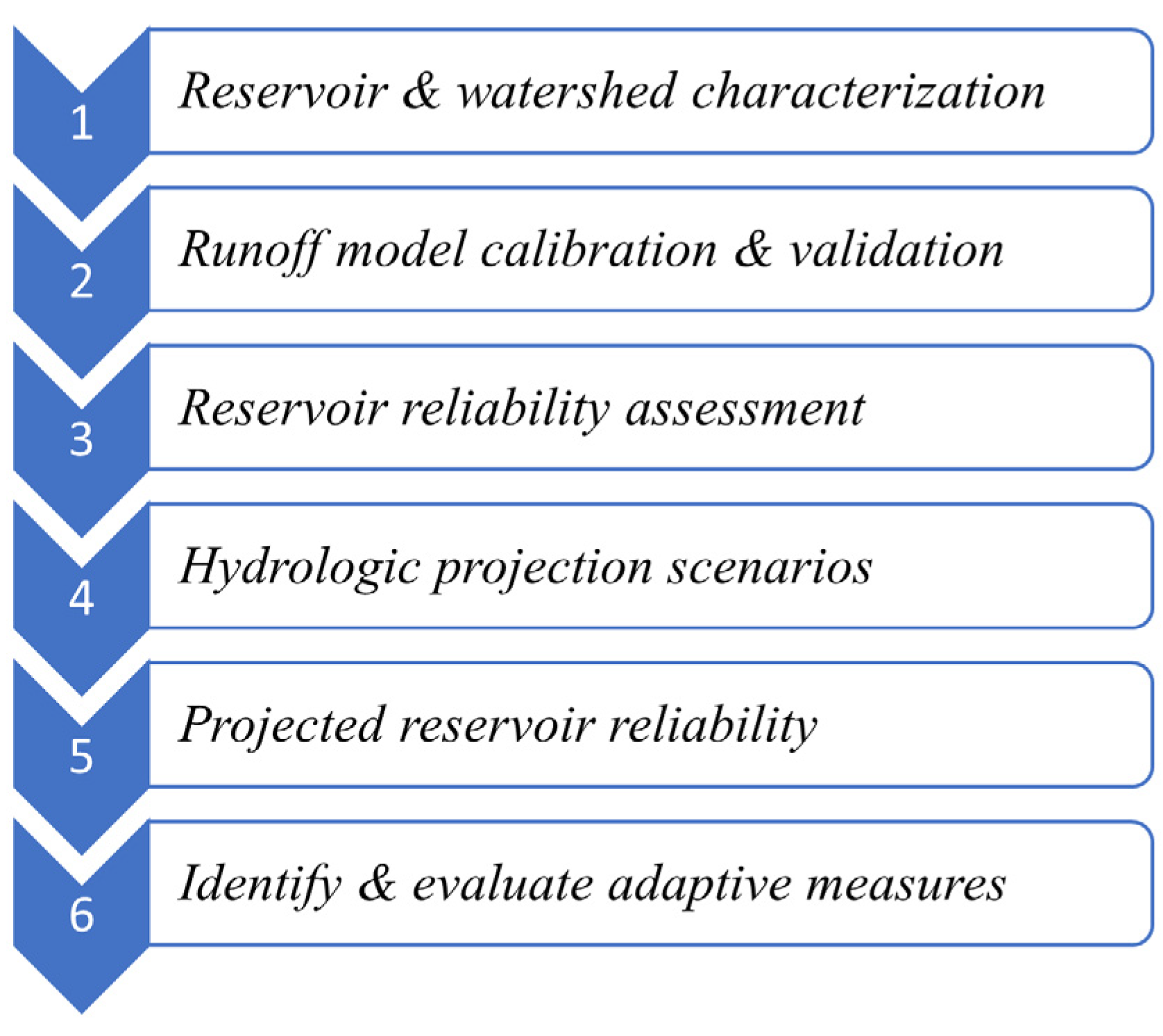
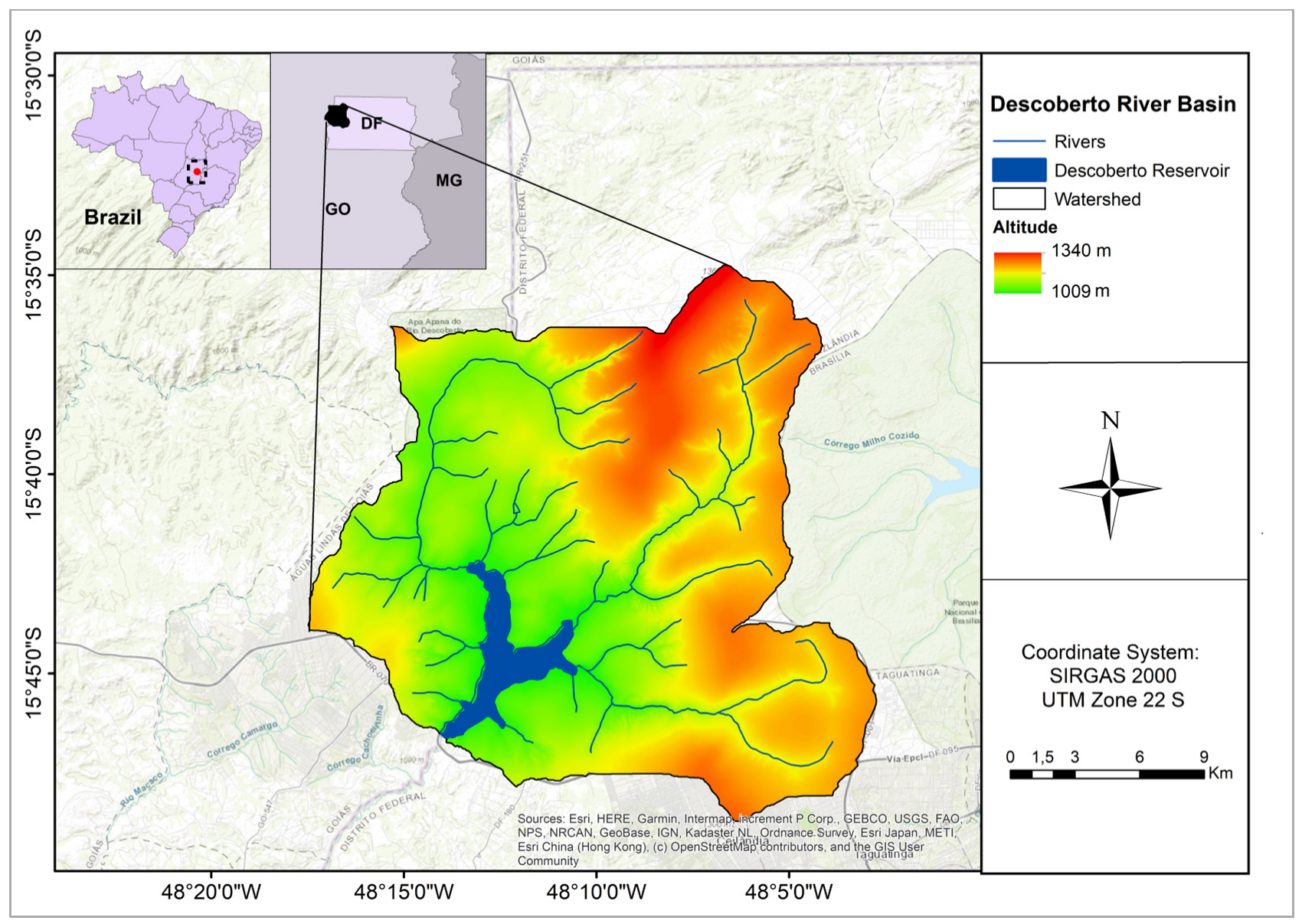
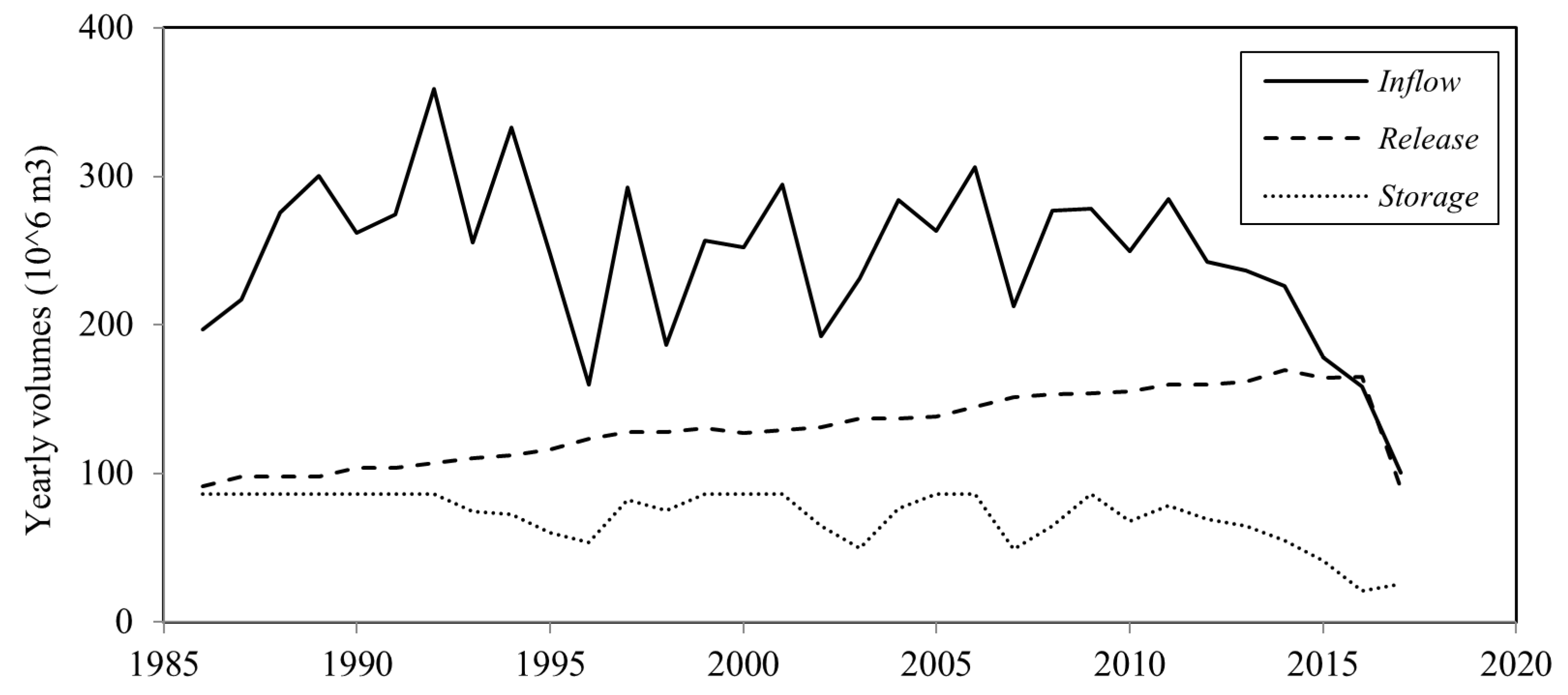

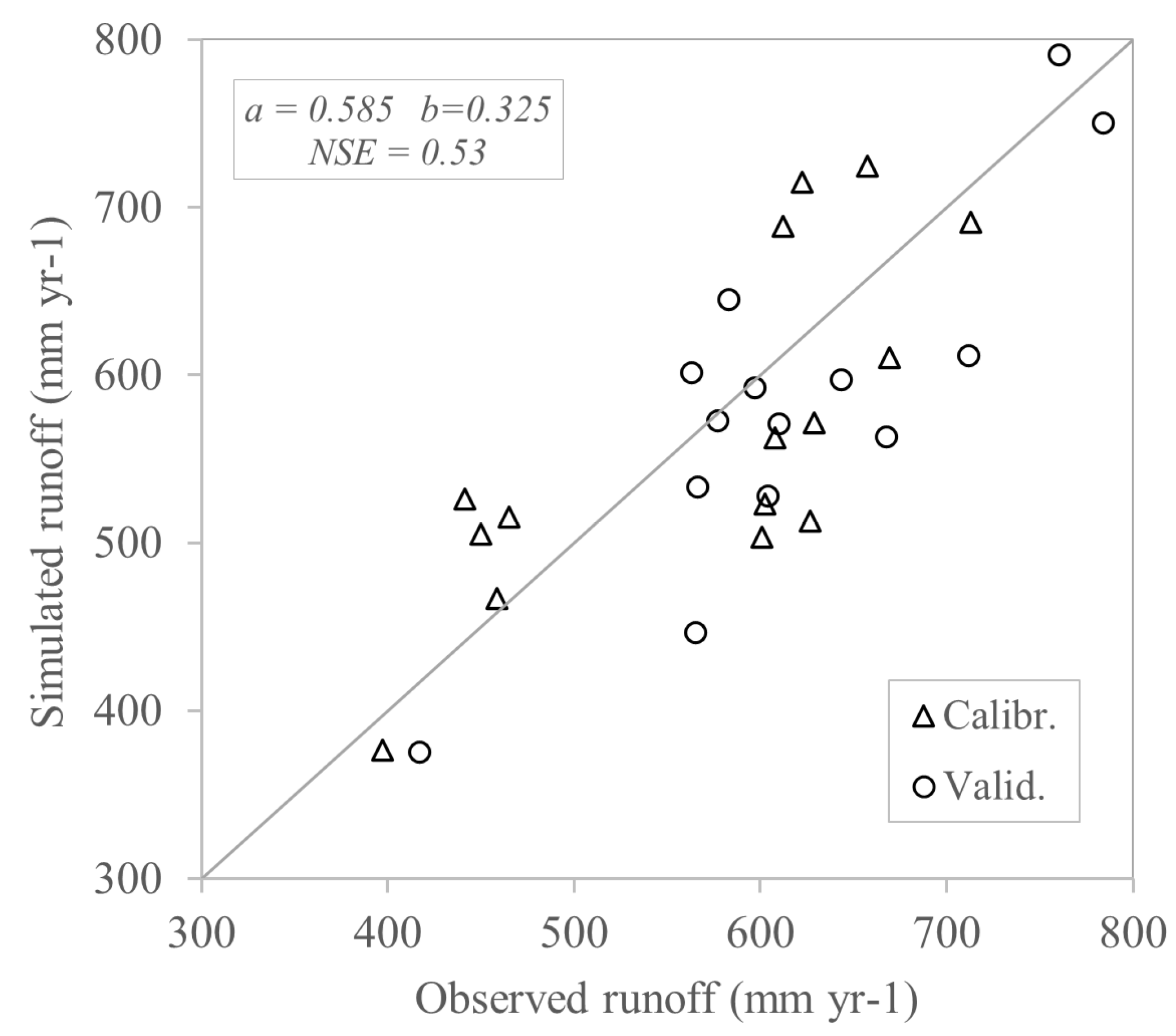
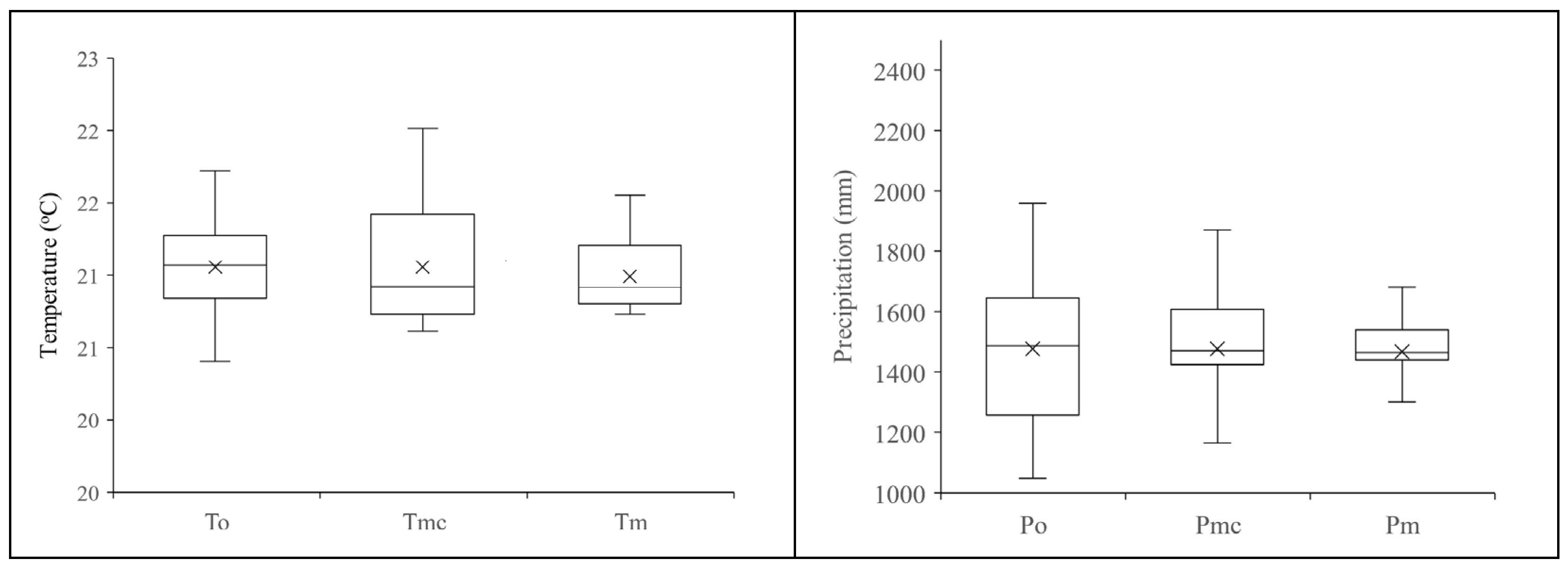
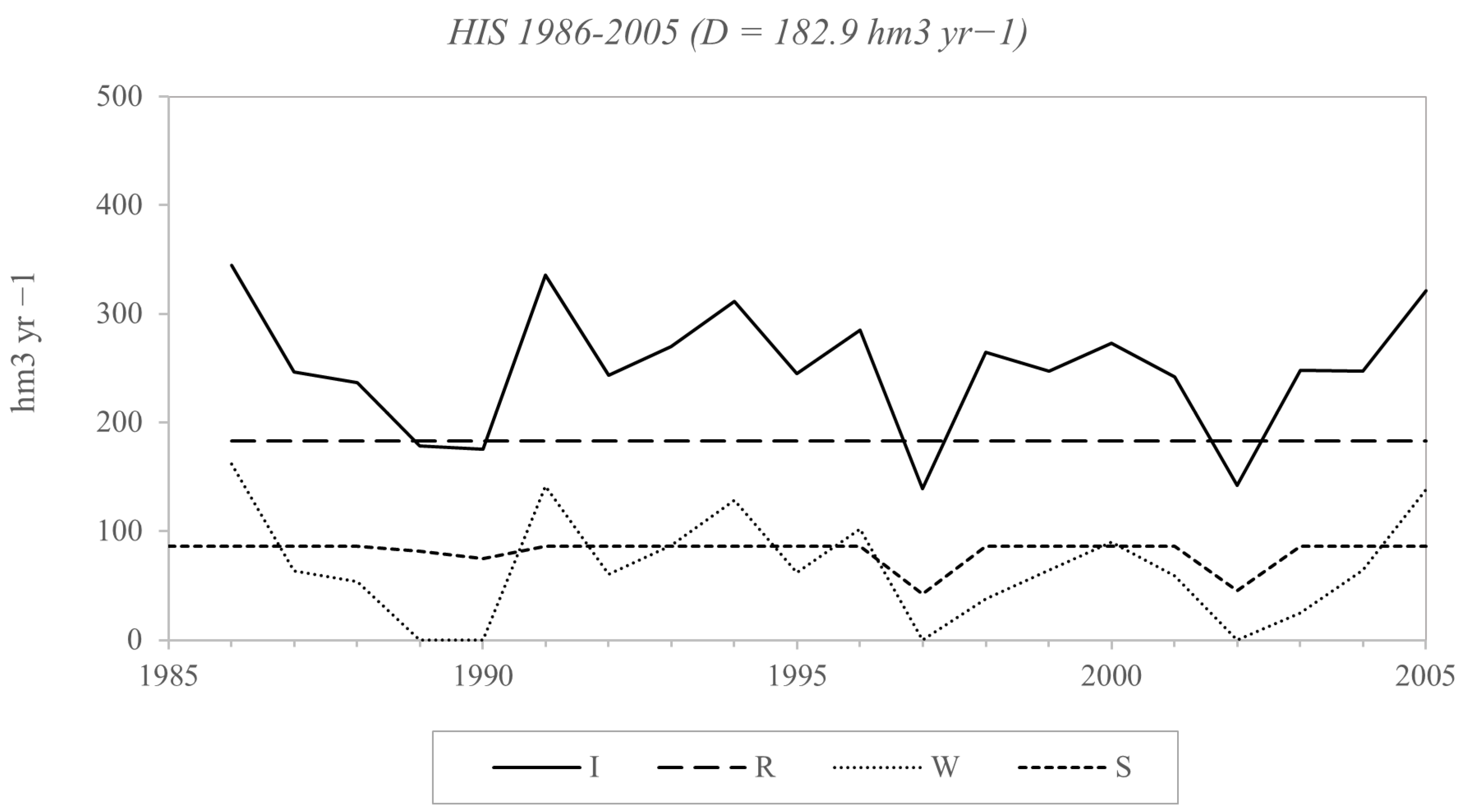
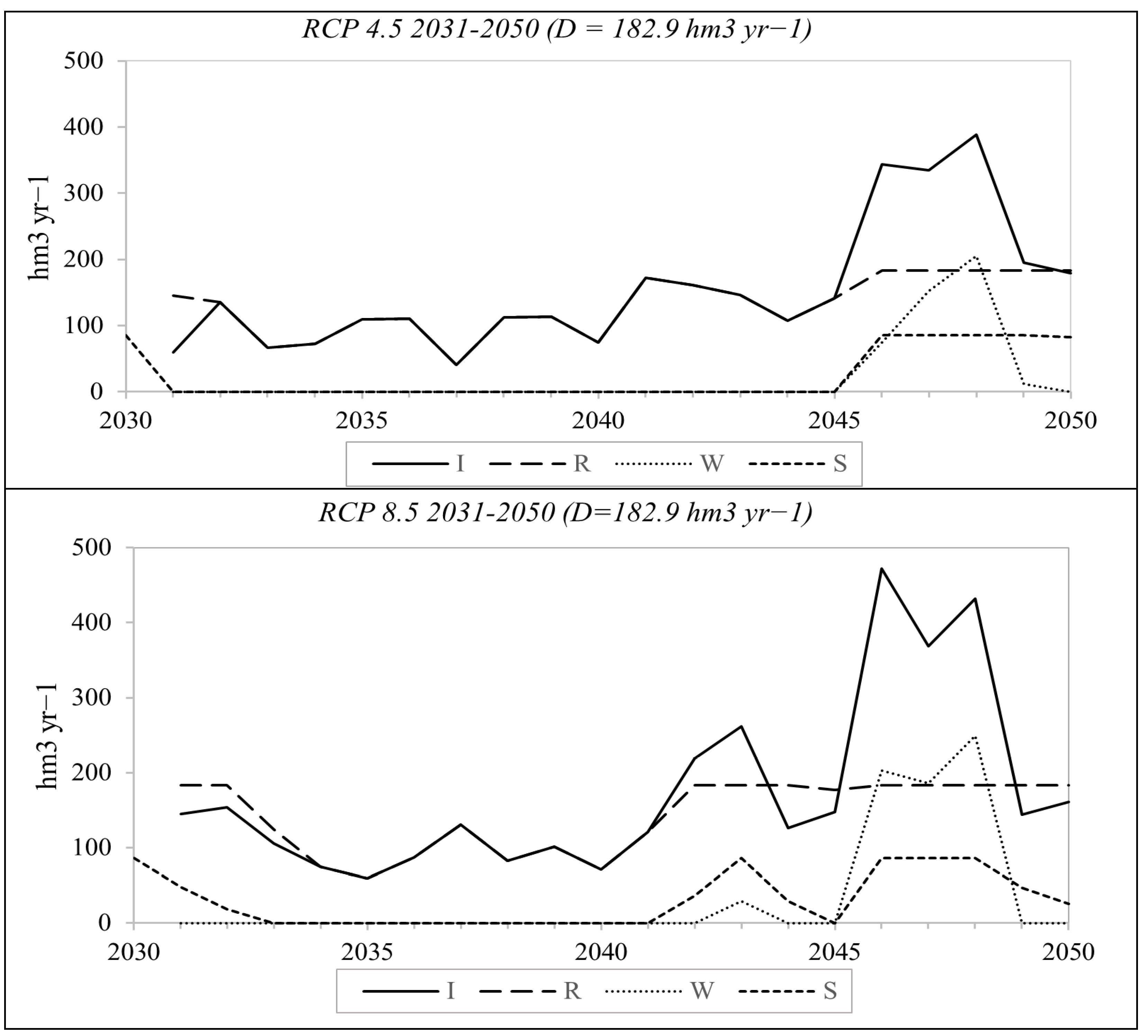


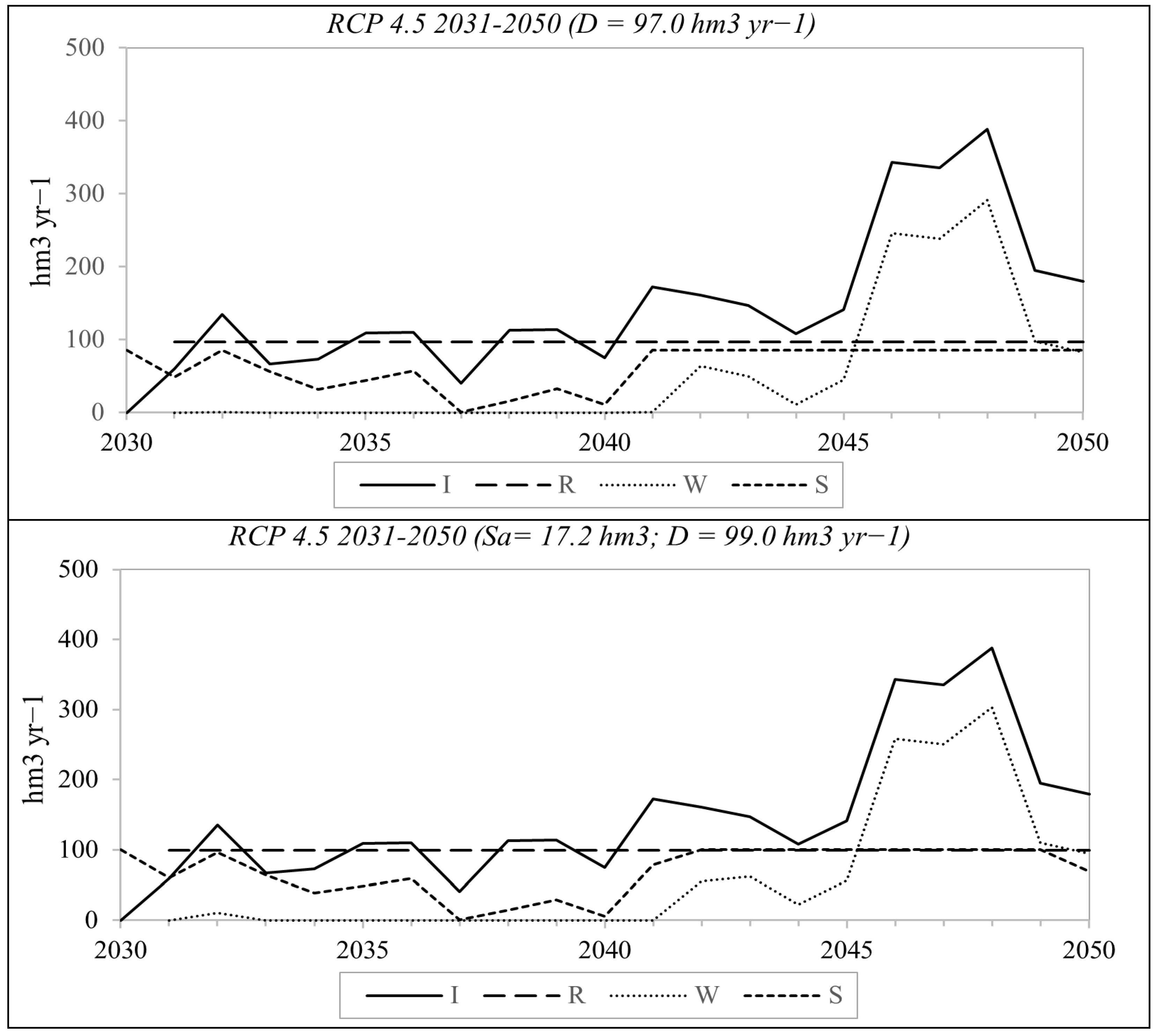
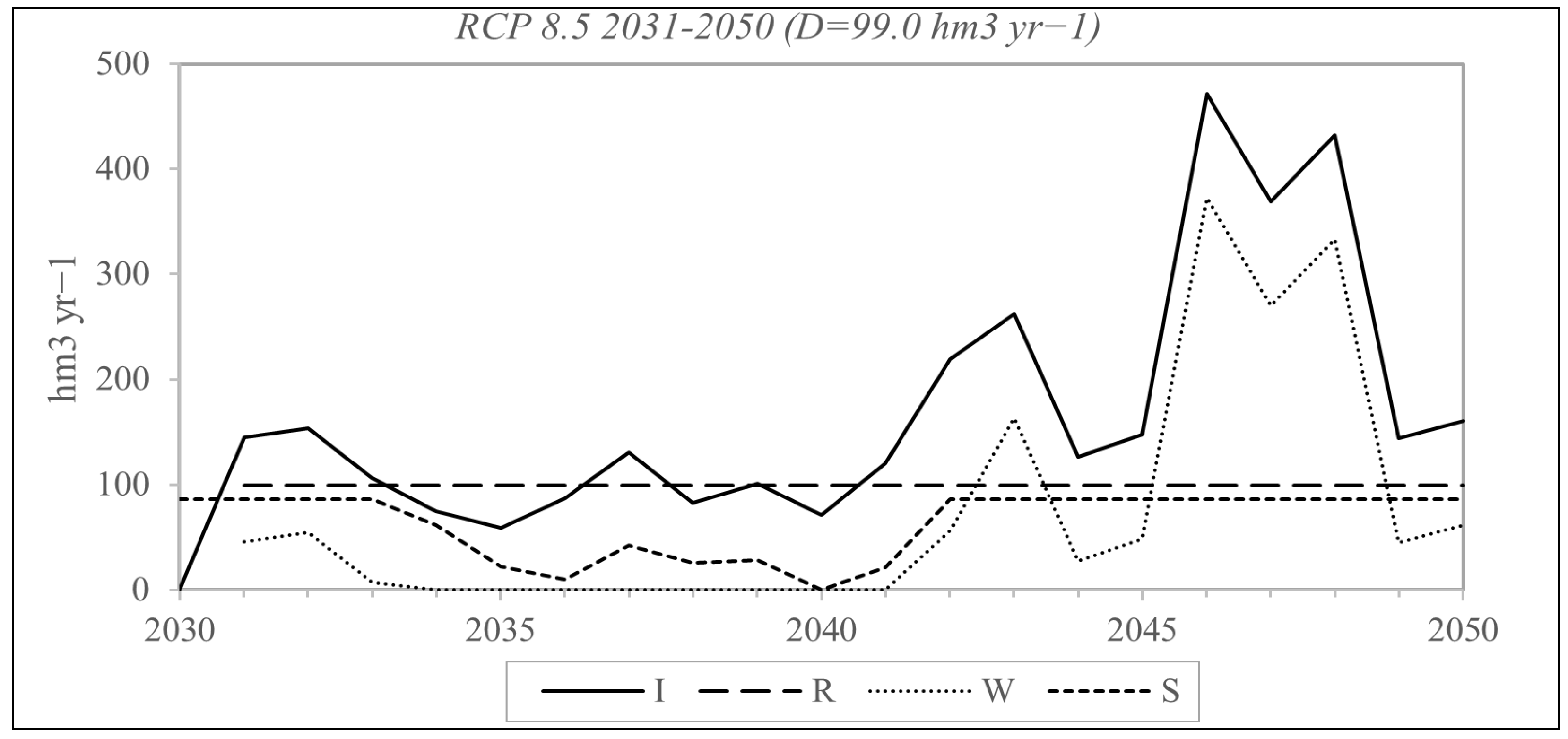


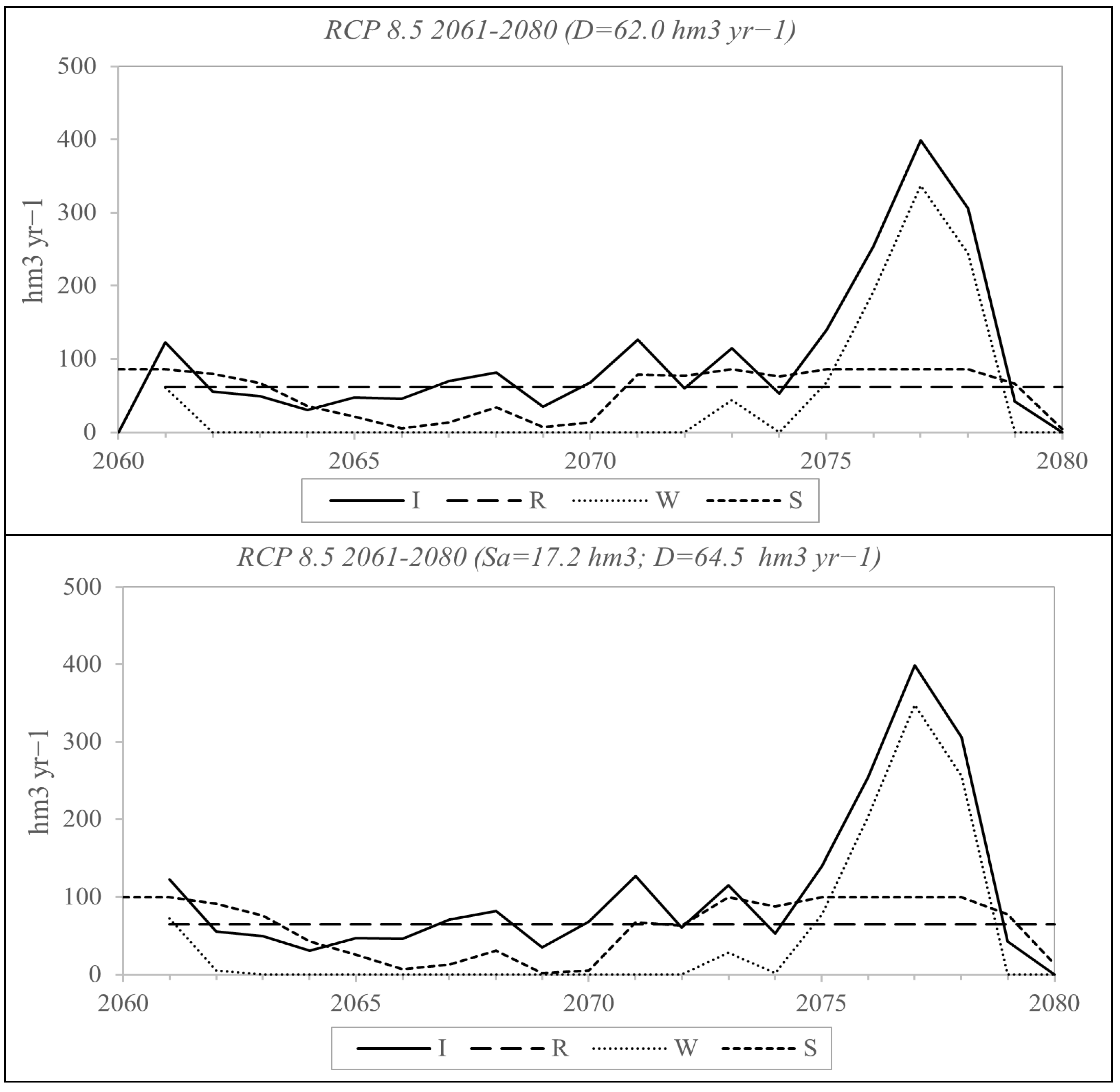
| Watershed Area | Reservoir Area | Active Volume | Mean Annual Inflow | C.V. of Inflows | Design Draft | Environ. Flow |
|---|---|---|---|---|---|---|
| (km2) | (km2) | (106 m3) | (106 m3 yr−1) | (%) | (106 m3 yr−1) | (106 m3 yr−1) |
| 430.7 | 12.6 | 86.0 | 251.1 | 19.1 | 163.4 | 19.6 |
| Measure | Type | Source |
|---|---|---|
| Draft reduction | Operational | [15] |
| Increased reservoir storage | Structural | [46] |
| Sedimentation management | Operational | [47] |
| Period | Scenario | P (mm) | CV [P] | T(°C) | CV [T] |
|---|---|---|---|---|---|
| 1986–2005 | HIS | 1474.3 | 0.16 | 21.0 | 0.01 |
| 2031–2050 | RCP 4.5 | 1082.0 *** | 0.40 | 22.8 *** | 0.01 |
| RCP 8.5 | 1178.6 ** | 0.44 | 23.2 *** | 0.02 | |
| 2061–2080 | RCP 4.5 | 1082.4 *** | 0.54 | 23.6 *** | 0.01 |
| RCP 8.5 | 886.1 *** | 0.55 | 25.3 *** | 0.02 |
| Period | Scenario | Q (mm) | CV [Q] | PET (mm) | CV [PET] |
|---|---|---|---|---|---|
| 1986–2005 | HIS | 580.0 | 0.23 | 1810.8 | 0.01 |
| 2031–2050 | RCP 4.5 | 356.0 *** | 0.63 | 1993.1 ** | 0.02 |
| RCP 8.5 | 404.2 ** | 0.69 | 2036.1 *** | 0.02 | |
| 2061–2080 | RCP 4.5 | 354.1 *** | 0.88 | 2074.0 *** | 0.01 |
| RCP 8.5 | 244.3 *** | 0.97 | 2274.8 *** | 0.03 |
| Period | Scenario | Mean Release (hm3 yr−1) | % of Orig. Draft | No. of Failures | Pf (%) | Rr (%) |
|---|---|---|---|---|---|---|
| 1986–2005 | HIS | 182.9 | 100.0 | 0 | 0 | 100 |
| 2031–2050 | RCP 4.5 | 131.3 | 71.7 | 15 | 75 | 25 |
| RCP 8.5 | 142.9 | 78.1 | 10 | 50 | 50 | |
| 2061–2080 | RCP 4.5 | 121.8 | 66.6 | 17 | 85 | 15 |
| RCP 8.5 | 93.3 | 51.0 | 16 | 80 | 20 |
| Period | Scenario | Adaptive Draft (hm3 yr−1) | % of Original Draft | Additional Storage (hm3) | Pf (%) | Rr (%) |
|---|---|---|---|---|---|---|
| 2031–2050 | RCP 4.5 | 97.0 | 53.0 | 0 | 0 | 100 |
| 99.0 | 54.1 | 17.2 | 0 | 100 | ||
| RCP 8.5 | 99.0 | 54.1 | 0 | 0 | 100 | |
| 101.0 | 55.2 | 17.2 | 0 | 100 | ||
| 2061–2080 | RCP 4.5 | 88.0 | 48.1 | 0 | 0 | 100 |
| 89.7 | 49.0 | 17.2 | 0 | 100 | ||
| RCP 8.5 | 62.0 | 33.9 | 0 | 0 | 100 | |
| 64.5 | 35.3 | 17.2 | 0 | 100 |
Disclaimer/Publisher’s Note: The statements, opinions and data contained in all publications are solely those of the individual author(s) and contributor(s) and not of MDPI and/or the editor(s). MDPI and/or the editor(s) disclaim responsibility for any injury to people or property resulting from any ideas, methods, instructions or products referred to in the content. |
© 2023 by the authors. Licensee MDPI, Basel, Switzerland. This article is an open access article distributed under the terms and conditions of the Creative Commons Attribution (CC BY) license (https://creativecommons.org/licenses/by/4.0/).
Share and Cite
Chaves, H.M.L.; da Silva, C.C.; Fonseca, M.R.S. Reservoir Reliability as Affected by Climate Change and Strategies for Adaptation. Water 2023, 15, 2323. https://doi.org/10.3390/w15132323
Chaves HML, da Silva CC, Fonseca MRS. Reservoir Reliability as Affected by Climate Change and Strategies for Adaptation. Water. 2023; 15(13):2323. https://doi.org/10.3390/w15132323
Chicago/Turabian StyleChaves, Henrique Marinho Leite, Camila Correa da Silva, and Maria Rita Souza Fonseca. 2023. "Reservoir Reliability as Affected by Climate Change and Strategies for Adaptation" Water 15, no. 13: 2323. https://doi.org/10.3390/w15132323





